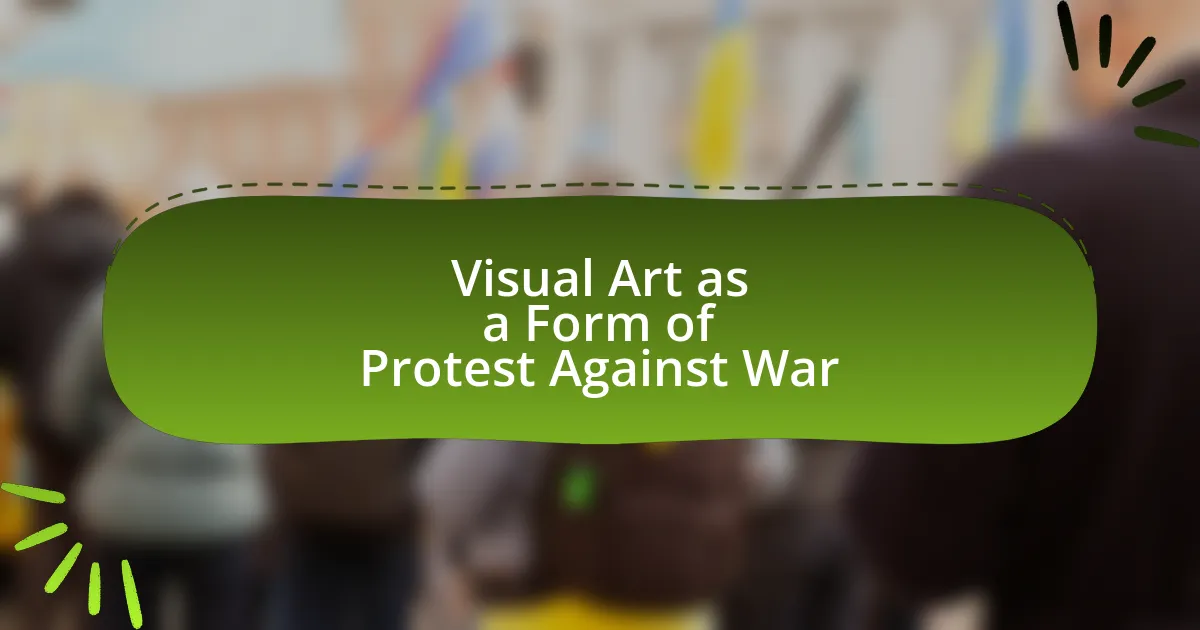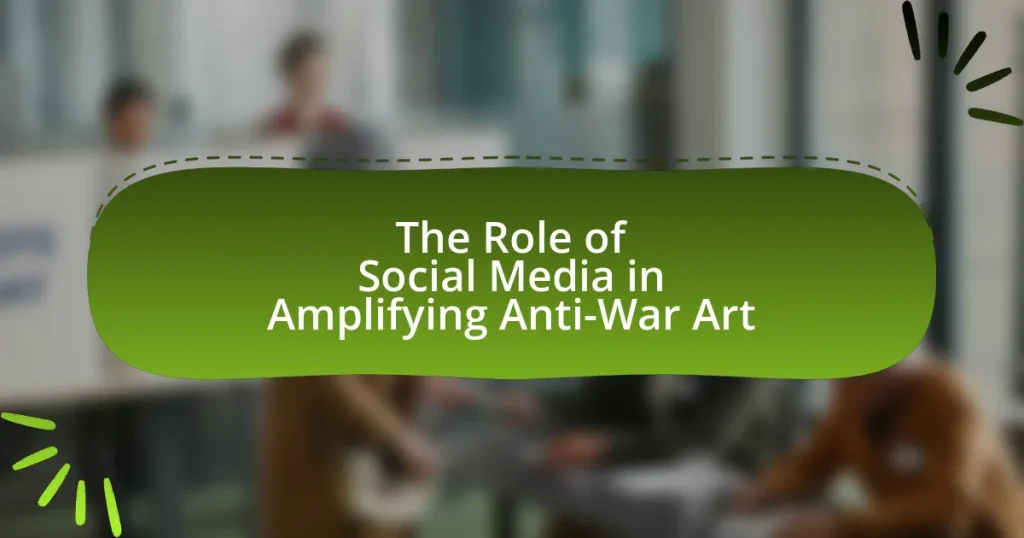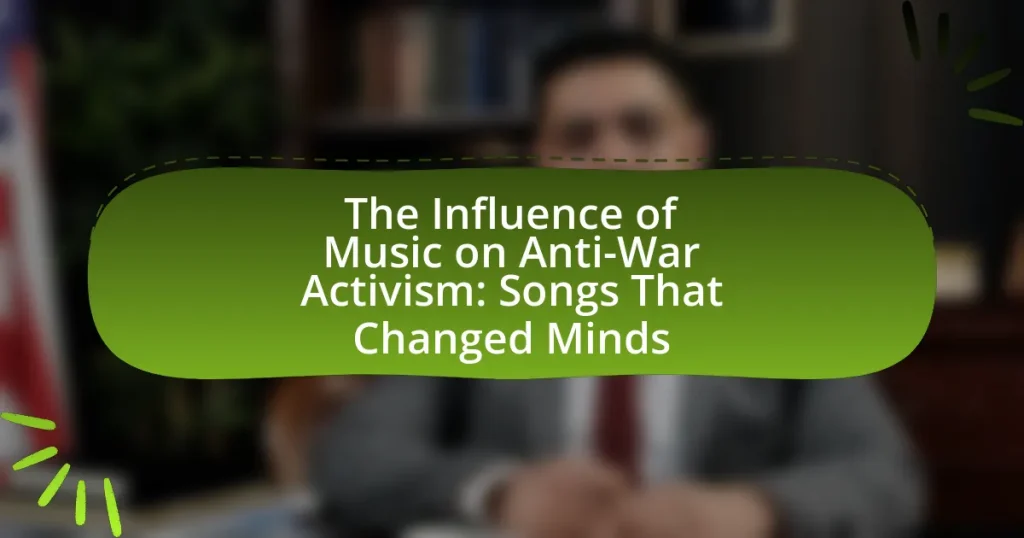Visual art serves as a powerful form of protest against war, utilizing various mediums to express opposition to military conflict and its consequences. The article explores historical and contemporary examples, such as Picasso’s “Guernica” and the Vietnam Veterans Memorial, highlighting how artists convey anti-war sentiments through symbolism, emotional imagery, and community engagement. It discusses the effectiveness of visual art in shaping public perception, mobilizing communities, and fostering dialogue about the human cost of war, while also addressing the challenges artists face, including censorship and financial constraints. Additionally, the article examines the role of digital art and social media in amplifying anti-war messages in today’s context.

What is Visual Art as a Form of Protest Against War?
Visual art as a form of protest against war is the use of artistic expression to convey opposition to military conflict and its consequences. Artists utilize various mediums, such as painting, sculpture, and installation, to communicate messages that critique war, highlight its human cost, and advocate for peace. Historical examples include Pablo Picasso’s “Guernica,” which powerfully depicts the horrors of the Spanish Civil War, and the Vietnam War protests, where artists created works that challenged U.S. involvement. These artworks serve as visual testimonies, raising awareness and fostering dialogue about the impact of war on society and individuals.
How has visual art historically been used to protest against war?
Visual art has historically been used to protest against war by conveying powerful messages that critique violence and advocate for peace. Artists like Pablo Picasso, through his painting “Guernica,” depicted the horrors of the Spanish Civil War, illustrating the suffering caused by conflict and serving as a universal symbol of anti-war sentiment. Similarly, the Vietnam War era saw artists like Robert Rauschenberg and Jasper Johns create works that challenged the glorification of war, using mixed media to express dissent. These artistic expressions not only reflect societal discontent but also mobilize public opinion against military actions, demonstrating the significant role of visual art in shaping anti-war discourse throughout history.
What are some notable examples of visual art used in anti-war movements?
Notable examples of visual art used in anti-war movements include Pablo Picasso’s “Guernica,” which powerfully depicts the horrors of the Spanish Civil War and critiques the brutality of war. Another significant work is the “Vietnam Veterans Memorial” in Washington, D.C., designed by Maya Lin, which honors the soldiers lost in the Vietnam War and serves as a poignant reminder of the conflict’s human cost. Additionally, the “Peace Symbol,” originally designed for the British nuclear disarmament movement in the 1950s, has become an enduring emblem of anti-war sentiment globally. These artworks not only convey strong anti-war messages but also engage the public in reflecting on the consequences of conflict.
How do different cultures express anti-war sentiments through visual art?
Different cultures express anti-war sentiments through visual art by utilizing symbolism, imagery, and cultural narratives that resonate with their historical experiences of conflict. For instance, in the United States, artists like Pablo Picasso with his painting “Guernica” depict the horrors of war and its impact on civilians, reflecting the Spanish Civil War’s brutality. In Japan, the “Hiroshima Panels” created by Iri and Toshi Maruki illustrate the devastation of the atomic bomb, serving as a poignant reminder of the consequences of warfare. Similarly, in the Middle East, artists often use calligraphy and traditional motifs to convey messages of peace and resistance against violence, as seen in the works of contemporary Palestinian artists who highlight the struggles of their people. These artistic expressions not only communicate anti-war sentiments but also foster cultural identity and collective memory, reinforcing the universal desire for peace across diverse societies.
Why is visual art an effective medium for protest against war?
Visual art is an effective medium for protest against war because it transcends language barriers and evokes emotional responses. This ability allows artists to communicate complex ideas and feelings about the horrors of war in a way that resonates universally. For instance, Pablo Picasso’s “Guernica” powerfully depicts the suffering caused by the Spanish Civil War, serving as a poignant visual condemnation of violence and conflict. Additionally, visual art can reach diverse audiences, making it a potent tool for raising awareness and fostering dialogue about the consequences of war. Historical examples, such as the anti-war posters from the Vietnam War era, demonstrate how visual art mobilizes public sentiment and encourages activism against military actions.
What emotional responses does visual art evoke in relation to war?
Visual art evokes a range of emotional responses in relation to war, including grief, anger, and empathy. These emotions arise as artists depict the harsh realities of conflict, often highlighting the suffering of individuals and communities affected by war. For instance, Pablo Picasso’s “Guernica” powerfully conveys the horror and chaos of the Spanish Civil War, eliciting feelings of despair and outrage. Similarly, contemporary works, such as those by Ai Weiwei, challenge viewers to confront the human cost of war and displacement, fostering a sense of compassion and urgency for social change. Through these emotional responses, visual art serves as a poignant medium for protest against the atrocities of war, encouraging reflection and dialogue on its impact.
How does visual art communicate messages that words may fail to convey?
Visual art communicates messages that words may fail to convey by utilizing visual elements to express complex emotions and ideas that transcend linguistic limitations. For instance, artworks like Pablo Picasso’s “Guernica” visually depict the horrors of war, evoking visceral reactions that words alone may not capture. The chaotic composition, stark contrasts, and distorted figures in “Guernica” convey the anguish and devastation of conflict, effectively communicating the anti-war sentiment without relying on textual explanation. This ability to evoke emotional responses through imagery allows visual art to articulate nuanced perspectives on war, making it a powerful medium for protest.
What are the different forms of visual art used in anti-war protests?
Different forms of visual art used in anti-war protests include posters, murals, installations, and performance art. Posters have historically been a primary medium, exemplified by the iconic “Make Love Not War” campaign during the Vietnam War, which effectively communicated anti-war sentiments. Murals, such as those created in the 1980s in Central America, visually depict the horrors of war and promote peace. Installations, like the “Field of Flags” project, use large-scale displays to symbolize loss and provoke emotional responses. Performance art, seen in events like “Theatre of the Oppressed,” engages audiences in critical discussions about war. These forms of visual art serve to raise awareness, evoke emotions, and mobilize communities against war.
What role do paintings and murals play in anti-war movements?
Paintings and murals serve as powerful tools in anti-war movements by visually conveying messages of peace, resistance, and the human cost of conflict. These artworks often depict the horrors of war, evoke emotional responses, and raise awareness about the consequences of violence, thereby mobilizing public sentiment against military actions. For instance, Pablo Picasso’s “Guernica” illustrates the devastation of the Spanish Civil War and has become an iconic symbol of anti-war sentiment, demonstrating how visual art can encapsulate complex emotions and historical events. Additionally, murals in urban areas often reflect community perspectives on war, fostering dialogue and solidarity among viewers. Through their accessibility and emotional impact, paintings and murals effectively engage audiences, making them integral to the discourse surrounding anti-war activism.
How do sculptures and installations contribute to the discourse on war?
Sculptures and installations contribute to the discourse on war by providing tangible representations of its impact, evoking emotional responses, and fostering critical dialogue. These art forms often depict the human cost of conflict, such as loss, suffering, and trauma, which can challenge viewers to confront uncomfortable truths about war. For instance, the Vietnam Veterans Memorial in Washington, D.C., serves as a poignant reminder of the lives lost, encouraging reflection and discussion about the consequences of military actions. Additionally, installations like “The Fallen” by artist David McCullough, which features thousands of boots to symbolize fallen soldiers, create a visceral connection to the realities of war, prompting public engagement and discourse. Through their ability to provoke thought and emotion, sculptures and installations play a crucial role in shaping societal perceptions and conversations surrounding war.
What impact do digital art and social media have on anti-war visual art?
Digital art and social media significantly enhance the reach and impact of anti-war visual art by facilitating widespread dissemination and engagement. Digital platforms allow artists to share their work globally, bypassing traditional gatekeepers like galleries and museums, which historically limited exposure. For instance, during the Iraq War, social media campaigns like “We Are the 99%” utilized visual art to mobilize public sentiment against military actions, demonstrating how digital art can influence public opinion and activism. Furthermore, the interactive nature of social media encourages dialogue and community building around anti-war messages, amplifying their resonance and effectiveness in contemporary discourse.
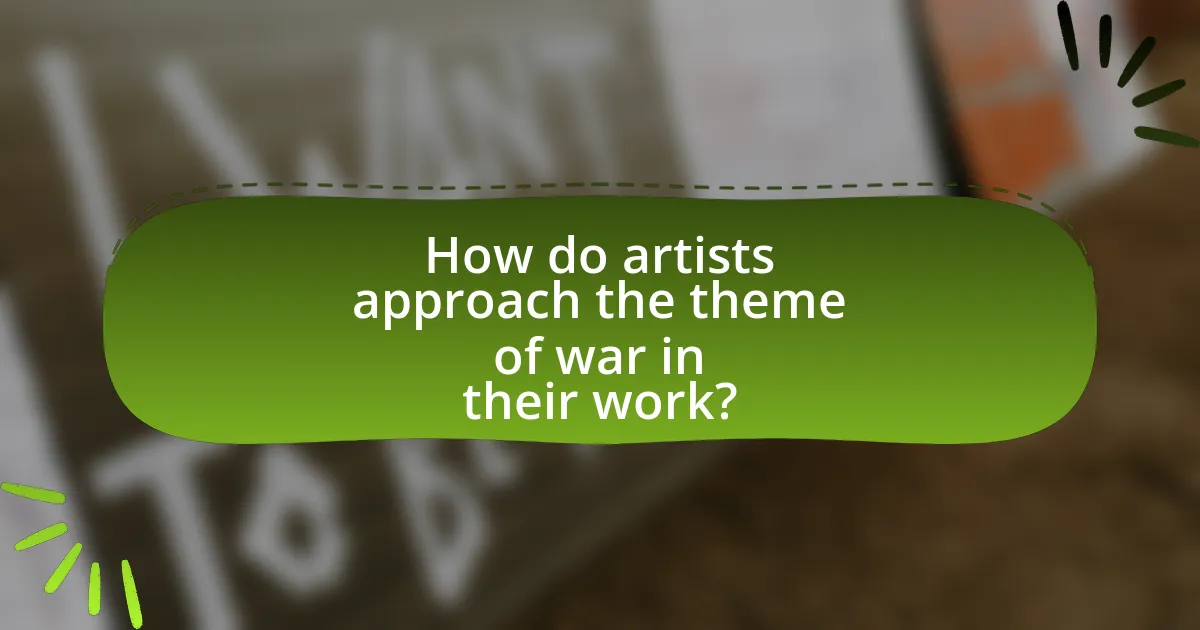
How do artists approach the theme of war in their work?
Artists approach the theme of war in their work by using visual imagery to convey the emotional and physical impacts of conflict. They often depict the horrors of battle, the suffering of civilians, and the psychological trauma experienced by soldiers, aiming to evoke empathy and provoke thought. For instance, Pablo Picasso’s “Guernica” illustrates the devastation of war through distorted figures and chaotic scenes, serving as a powerful anti-war statement. Similarly, contemporary artists like Ai Weiwei utilize installations and multimedia to critique militarism and highlight the plight of refugees, reinforcing the message that art can be a form of protest against the violence and destruction caused by war.
What techniques do artists use to convey their anti-war messages?
Artists use techniques such as symbolism, satire, and emotional imagery to convey their anti-war messages. Symbolism allows artists to represent complex ideas about war and its consequences through visual metaphors, such as using broken toys to symbolize lost childhoods. Satire critiques the absurdities of war, often employing humor or exaggeration to highlight the folly of conflict, as seen in works like George Grosz’s paintings during World War I. Emotional imagery evokes strong feelings in viewers, often depicting the suffering of civilians or the horrors of battle, which can be seen in Pablo Picasso’s “Guernica,” a powerful response to the bombing of a Spanish town. These techniques effectively communicate the artists’ perspectives on war, engaging audiences and prompting reflection on its impacts.
How does symbolism play a role in visual art related to war?
Symbolism plays a crucial role in visual art related to war by conveying complex emotions and messages that reflect the human experience of conflict. Artists often use symbols such as doves to represent peace, skulls to signify death, or barbed wire to illustrate entrapment and suffering. For instance, Pablo Picasso’s “Guernica” employs fragmented forms and monochromatic tones to symbolize the chaos and brutality of war, specifically referencing the bombing of Guernica during the Spanish Civil War. This artwork serves as a powerful anti-war statement, illustrating how symbolism can evoke strong emotional responses and provoke thought about the consequences of violence.
What are the common themes found in anti-war visual art?
Common themes found in anti-war visual art include the portrayal of suffering, the critique of militarism, and the exploration of peace. Artists often depict the physical and emotional toll of war on individuals and communities, highlighting the devastation and loss experienced by civilians and soldiers alike. Additionally, anti-war art frequently challenges the glorification of military actions and the political motives behind wars, using symbolism and imagery to provoke thought and discussion. The theme of peace is also prevalent, with artists envisioning a world free from conflict and advocating for reconciliation and understanding. These themes are evident in works from various historical contexts, such as Pablo Picasso’s “Guernica,” which powerfully illustrates the horrors of war and its impact on humanity.
How do societal and political contexts influence visual art as protest?
Societal and political contexts significantly influence visual art as protest by shaping the themes, messages, and mediums artists choose to express dissent. For instance, during the Vietnam War, artists like Pablo Picasso and Andy Warhol utilized their work to critique the conflict, reflecting widespread anti-war sentiment in society. The political climate often dictates the urgency and focus of artistic expression; for example, the Civil Rights Movement inspired powerful imagery that highlighted racial injustice, as seen in the works of artists like Faith Ringgold. Furthermore, societal reactions to political events can lead to the emergence of specific art movements, such as Dadaism, which arose in response to World War I’s devastation. These contexts not only inform the content of the artwork but also influence public reception and the potential for social change, demonstrating that visual art serves as a vital tool for protest against prevailing political and social injustices.
What historical events have sparked significant anti-war visual art movements?
Significant anti-war visual art movements have been sparked by events such as World War I, the Vietnam War, and the Iraq War. The devastation and human suffering caused by World War I led artists like Otto Dix and George Grosz to create works that criticized the war’s brutality. The Vietnam War inspired a wave of protest art in the 1960s and 1970s, with artists like David Hockney and the use of graphic imagery in posters and murals to convey the horrors of conflict. Similarly, the Iraq War prompted artists such as Jenny Holzer and the collective known as the “Art for Iraq” project to produce works that addressed the consequences of war and questioned governmental narratives. These events catalyzed artistic expressions that challenged the glorification of war and highlighted its tragic realities.
How do contemporary issues shape the creation of anti-war art today?
Contemporary issues significantly influence the creation of anti-war art today by reflecting societal concerns such as political conflict, human rights violations, and environmental crises. Artists respond to current events, using their work to critique government actions, highlight the human cost of war, and advocate for peace. For instance, the rise of social media has allowed artists to disseminate their messages rapidly, reaching wider audiences and fostering global conversations about war and its impacts. Additionally, movements like Black Lives Matter and climate activism have inspired artists to incorporate themes of justice and sustainability into their anti-war narratives, emphasizing interconnectedness in struggles against oppression. This dynamic interplay between contemporary issues and artistic expression ensures that anti-war art remains relevant and impactful in addressing the complexities of modern warfare.
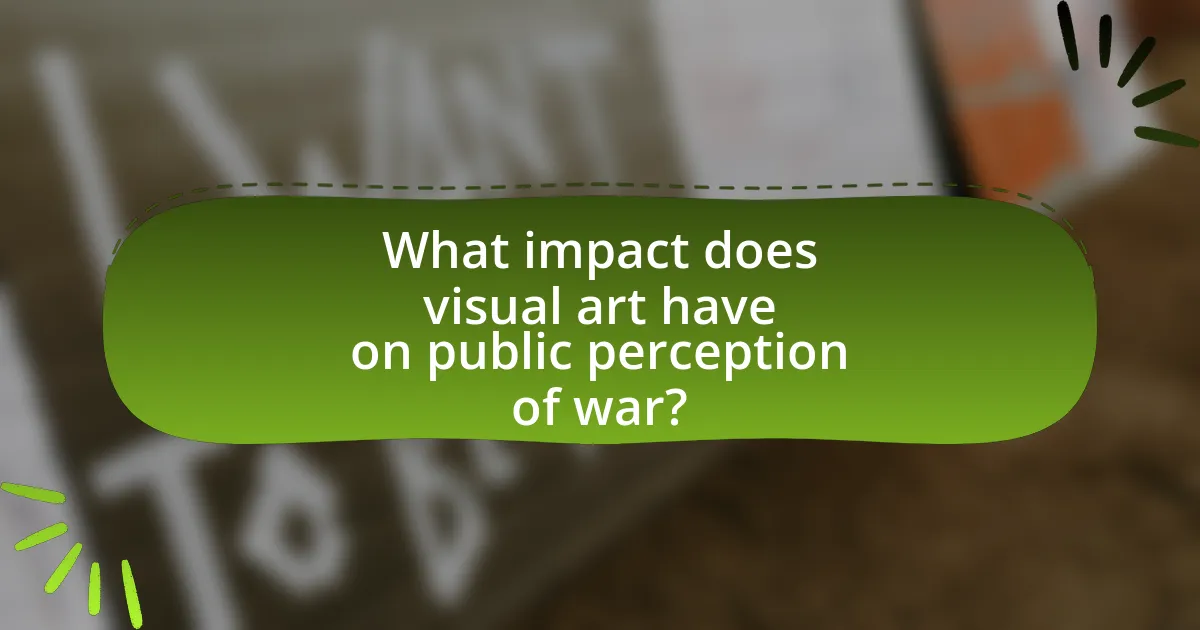
What impact does visual art have on public perception of war?
Visual art significantly influences public perception of war by shaping emotional responses and providing critical commentary on conflict. Through powerful imagery and symbolism, artists can evoke empathy, challenge narratives, and highlight the human cost of war. For instance, Pablo Picasso’s “Guernica” serves as a poignant anti-war statement, depicting the horrors of the Spanish Civil War and influencing public sentiment against violence. Research indicates that visual representations of war can alter viewers’ attitudes, making them more aware of the consequences of conflict and fostering a desire for peace. This impact is evident in various movements where art has been used to protest against military actions, effectively mobilizing public opinion and encouraging discourse on the ethics of war.
How does visual art influence public opinion regarding war?
Visual art significantly influences public opinion regarding war by evoking emotional responses and shaping perceptions through imagery and symbolism. For instance, artworks like Picasso’s “Guernica” powerfully depict the horrors of war, leading viewers to empathize with victims and question the morality of conflict. Historical evidence shows that visual art has been used in various movements, such as anti-war protests during the Vietnam War, where posters and murals conveyed strong anti-war sentiments, mobilizing public dissent and altering perceptions about military involvement. This demonstrates that visual art serves as a critical medium for commentary and reflection on the impacts of war, ultimately swaying public opinion.
What role does visual art play in shaping narratives around conflict?
Visual art plays a crucial role in shaping narratives around conflict by providing a powerful medium for expression and communication. Artists often depict the emotional and psychological impacts of war, allowing viewers to engage with the human experiences behind conflicts. For instance, works like Pablo Picasso’s “Guernica” illustrate the horrors of war and evoke empathy, influencing public perception and discourse. Additionally, visual art can serve as a form of protest, challenging dominant narratives and highlighting marginalized voices. The use of art in social movements, such as the anti-war protests during the Vietnam War, demonstrates its effectiveness in mobilizing public sentiment and fostering awareness. Thus, visual art not only reflects but actively shapes the understanding of conflict through its ability to convey complex emotions and provoke critical thought.
How can visual art mobilize communities against war?
Visual art can mobilize communities against war by serving as a powerful medium for expression and communication that resonates emotionally with individuals. Through visual narratives, artists can depict the horrors of conflict, evoke empathy, and inspire collective action. For instance, the anti-war murals created during the Vietnam War era galvanized public sentiment and fostered community solidarity against military involvement. Additionally, art installations and public exhibitions can create spaces for dialogue, encouraging community members to engage in discussions about the impacts of war and the importance of peace. Historical examples, such as the “Guernica” painting by Pablo Picasso, illustrate how visual art can capture the devastation of war and motivate communities to advocate for change.
What are some challenges faced by artists creating anti-war visual art?
Artists creating anti-war visual art face several challenges, including censorship, public backlash, and the difficulty of conveying complex emotions. Censorship can occur when governments or institutions restrict the display of art that critiques war, limiting artists’ freedom of expression. Public backlash may arise from audiences who disagree with the anti-war message, leading to negative reception and potential isolation for the artist. Additionally, the challenge of effectively communicating the multifaceted nature of war—such as trauma, loss, and moral dilemmas—can complicate the artistic process, as artists strive to evoke empathy and provoke thought in a society often desensitized to violence.
How do censorship and political backlash affect anti-war artists?
Censorship and political backlash significantly restrict the creative expression of anti-war artists, often leading to self-censorship or the suppression of their work. For instance, during the Vietnam War, artists faced government scrutiny and public backlash, which resulted in limited exhibition opportunities and funding for anti-war projects. This suppression not only stifles artistic freedom but also diminishes the impact of their messages, as seen when prominent anti-war artworks were removed from galleries or faced legal challenges. Such actions create an environment where artists may feel compelled to alter their content or abandon their themes altogether, ultimately undermining the role of visual art as a powerful form of protest against war.
What financial and logistical challenges do artists encounter in this field?
Artists in the field of visual art as a form of protest against war face significant financial and logistical challenges. Financially, many artists struggle with securing funding for their projects, as grants and sponsorships are often limited, particularly for politically charged work. For instance, a study by the National Endowment for the Arts found that only 4% of artists receive grants, which can hinder their ability to create impactful pieces. Logistically, artists encounter difficulties in accessing materials and venues, as well as navigating bureaucratic hurdles related to permits and regulations for public displays. These challenges can impede their ability to effectively communicate their messages and reach wider audiences.
What practical steps can artists take to effectively use visual art as a form of protest against war?
Artists can effectively use visual art as a form of protest against war by creating impactful imagery that conveys the horrors and consequences of conflict. This can include producing paintings, murals, or installations that depict the suffering of civilians, the destruction of communities, or the futility of war. For instance, the anti-war artwork of Pablo Picasso, particularly “Guernica,” serves as a historical example of how visual art can evoke strong emotional responses and raise awareness about the tragedies of war. Additionally, artists can collaborate with activist groups to organize exhibitions that focus on war-related themes, thereby reaching a broader audience and fostering dialogue. Engaging in public art projects, such as street art or community murals, can also amplify their message by making it accessible to the general public. Furthermore, utilizing social media platforms to share their work can enhance visibility and encourage discussions around the impact of war, as seen in campaigns like #ArtForPeace.
How can artists engage with their communities to amplify their messages?
Artists can engage with their communities to amplify their messages by creating collaborative projects that involve local residents in the artistic process. For instance, community murals or public installations allow artists to express their views while inviting community members to contribute their perspectives, fostering a sense of ownership and shared purpose. Research indicates that participatory art projects can enhance social cohesion and empower marginalized voices, as seen in initiatives like the “Mural Arts Program” in Philadelphia, which has successfully transformed neighborhoods and sparked dialogue around social issues. By actively involving the community, artists not only amplify their messages but also create a platform for collective expression and awareness.
What resources are available for artists looking to create anti-war visual art?
Artists looking to create anti-war visual art can access various resources, including grants, workshops, and online platforms dedicated to social justice art. Organizations such as the Creative Capital Foundation provide funding specifically for projects that address social issues, including war. Additionally, platforms like Art for Peace and the Center for Artistic Activism offer workshops and resources that focus on using art as a tool for activism. Furthermore, online communities and social media groups can facilitate collaboration and sharing of ideas among artists committed to anti-war themes. These resources collectively support artists in expressing their anti-war sentiments through visual art.
